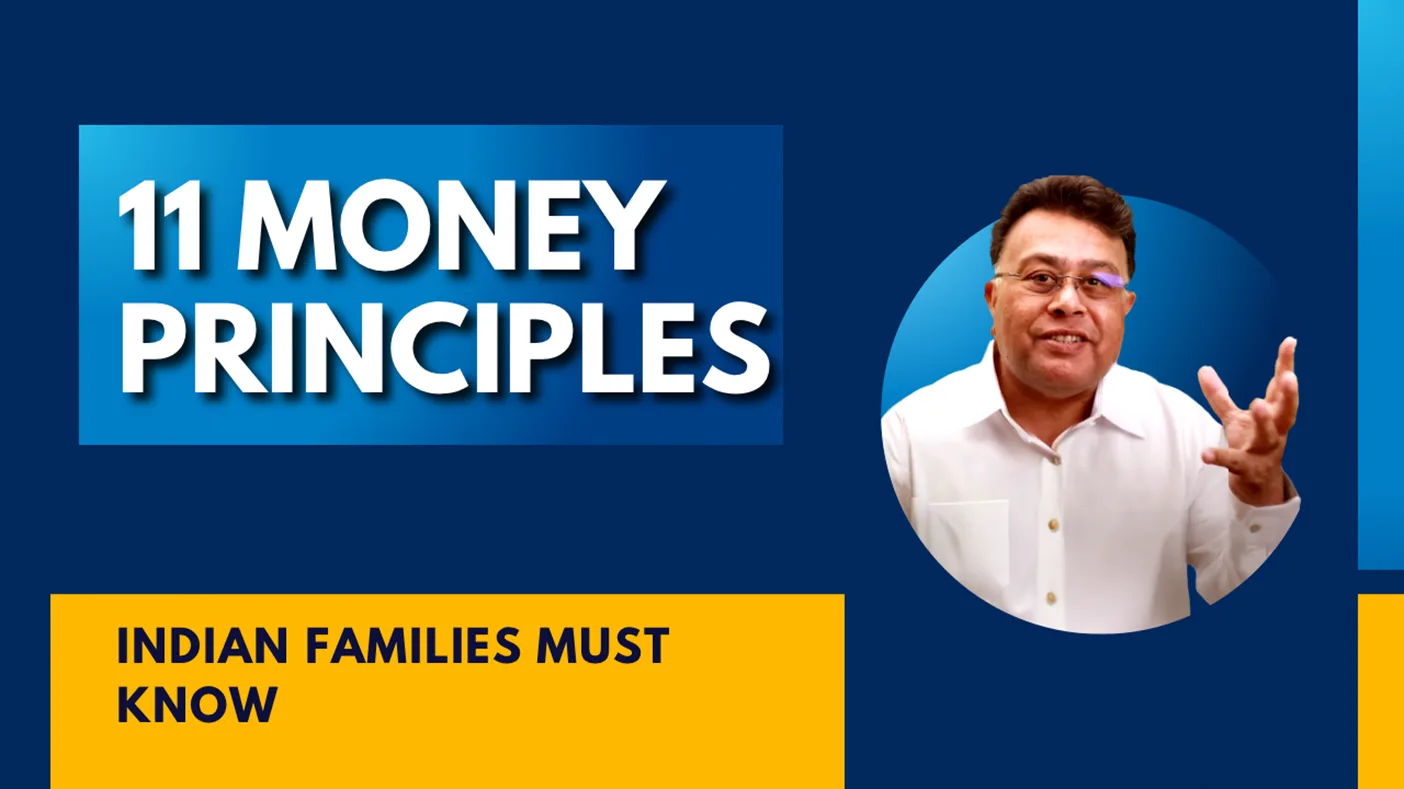Introduction – The Question That Changed How I Look at Money
One afternoon in Gurugram, a young professional walked into my office. He was well-dressed, confident, and earning ₹40 lakh a year. Yet when I asked him, “How secure do you feel about your money?” he sighed, “Honestly, Taresh, I don’t know. I’m earning well, but I feel I’m always running. Is this how it’s supposed to be?”
That question is one I’ve heard many times. Across my years as a CFP, I’ve met schoolteachers, army officers, startup founders, corporate executives, single mothers, and retirees. They all work hard, save something, and yet most feel insecure about their finances.
I realised that what Indians need is not more products or schemes, but clear principles that make money simpler and life richer. Today, I’m sharing 11 principles that I’ve lived by, taught my clients, and seen transform lives.
1. Earning is Only the First Step — Don’t Stop There
In India, we grow up hearing that a good job is the key to a good life. Parents push us toward stable careers. And yes, earning matters. But I’ve seen too many high-salary clients still living month-to-month.
A few years ago, I met a 35-year-old IT manager who earned ₹40 lakh per year. He was respected at work, but when we looked at his finances, everything was tied up in EMIs, lifestyle spending, and taxes. Contrast that with a schoolteacher I advised, who, in addition to her salary, ran a small tiffin service earning ₹15,000 per month. She had a second source of income, and her savings rate was higher than that of the IT manager.
The truth is, in India, salary alone is never enough. Inflation, family obligations, and lifestyle costs rise faster than paychecks. The ones who do well are those who build side incomes — freelancing, rental income, digital products, even small family businesses.
Action step: Ask yourself, “What income streams can I create besides my job?” Even an extra ₹5,000 a month invested wisely can change your future.
2. Compounding is the Eighth Wonder of the Indian Middle Class
I often tell young people: compounding is like planting a mango tree. The best time was yesterday; the second-best time is today.
Two cousins once came to me. One had started an SIP of ₹5,000 at age 25. The other said, “I’ll start later when I earn more.” At 35, the second cousin began with ₹15,000 per month. By the time both were 45, the younger starter was far ahead, despite investing less each month. Time had worked its magic.
This is why I insist — don’t wait for a perfect salary. Don’t wait for marriage, or kids, or a house. Start now. Your future self will thank you.
Action step: Begin an SIP today, however small. Increase it every year by at least 10%. Time and discipline will do the rest.
3. Save Aggressively Early, Then Shift to Investing
In our 20s, lifestyle spending is tempting — bikes, vacations, gadgets. But I’ve seen extraordinary results when people save heavily in their early years.
One software engineer client of mine saved nearly 40% of his salary in his first 5 years of work. He lived with roommates, didn’t rush into buying property, and avoided loans. By 30, he had a sizeable base. At that point, he began shifting towards equity mutual funds. By 50, he was financially independent, while many of his peers were still paying EMIs.
The strategy is simple: your 20s are the time to build the habit of saving. Your 30s and 40s are the time to let investing take over.
Action step: In your first decade of earning, focus on saving more than spending. Later, let investments grow faster than your savings.
4. Don’t Obsess Over Cutting Chai; Focus on Big Wins
Much advice tells you to cut down on coffee or eating out. I disagree. It’s not the chai that ruins Indian families’ finances. It’s the big-ticket decisions.
I worked with a family who proudly told me they avoided vacations, ate at home, and lived frugally. But they had taken a ₹1.5 crore home loan on a ₹25 lakh salary. Their EMI consumed half their income. Stress followed them everywhere.
On the other hand, I know families who enjoy their dinners out, but who wait to buy property until it is genuinely affordable. They are far more relaxed financially.
Action step: Focus your discipline on the big wins: house, car, education, weddings. That’s where financial futures are made or broken.
5. Should You Choose Index Funds or Active Funds in India?
In the US, index funds dominate. In India, the picture is more nuanced. I had a client who returned from the US, convinced that only index investing works. He ignored all actively managed Indian funds. But when we compared, he was shocked — certain active funds in India had beaten the index consistently, especially in mid-cap and small-cap categories.
The Indian market is still young and inefficient compared to developed markets. That creates opportunities for skilled fund managers.
Action step: Don’t mindlessly copy Western strategies. In India, a mix works best: index funds for large-cap stability, active funds for growth. Review yearly with your advisor.
6. Property is Not Always the Pride of Ownership
Ask any Indian family what their biggest dream is, and they’ll say: “Apna ghar.” Owning a house is emotional. But rushing into it can backfire.
One young couple I advised bought a flat at 32 with a massive EMI. For the next decade, every salary hike went into the loan. They couldn’t start SIPs, couldn’t travel, couldn’t live freely. By 40, they had a house but no wealth.
Meanwhile, another couple chose to rent for 10 years, invested aggressively in mutual funds, and then bought a home later with a smaller loan. They had both the house and the wealth.
Action step: Buy property when you can do so without choking your monthly cash flow. A rented house with investments is better than an owned house with no freedom.
7. Gold — Emotional, but Not Enough for Growth
Gold is in our festivals, marriages, and traditions. I grew up hearing my grandmother say, “Beta, sona kabhi dhokha nahi deta.” And she was right — gold is a protector.
But I’ve seen families with kilos of gold but no equity exposure. Yes, their wealth doubled in 20 years, but equities could have multiplied it 10 times.
Gold is safety, not growth.
Action step: Limit gold to 5–10% of your portfolio. Treat it as insurance, not an investment.
8. The EMI Trap vs. Smart Borrowing
The new middle class in India often drowns in EMIs — car loans, phones, holidays, even furniture. I call it “monthly slavery.”
I met a young couple earning ₹3 lakh monthly but paying ₹2.2 lakh in EMIs. Every conversation about children stressed them out. They had the appearance of wealth but none of the peace.
Contrast this with a businessperson who took a loan only to expand his factory. His debt created more income. That’s the difference between wise and foolish borrowing.
Action step: Borrow only for assets that grow or generate income. Avoid borrowing for consumption. Live EMI-light.
9. Your Wealth is Assets, Not Salary Slips
I’ve met executives with ₹50 lakh annual income but less wealth than a nurse earning ₹6 lakh. Why? Because the nurse invested ₹15,000 every month for 20 years, while the executive spent everything.
One of my most humbling experiences was working with her. She didn’t compare herself with anyone, but today she has a ₹1.5 crore corpus. Her doctor husband, with triple her income, has barely ₹30 lakh.
Action step: Track your net worth, not just your income. Ask yourself: “What do I own that will still be with me if my salary stops tomorrow?”
10. Luck and Timing Play a Role — But Don’t Depend on Them
In 2008, one client started investing when the stock market had crashed. Within 5 years, his portfolio doubled. Another entered at the 2021 peak and panicked when markets corrected.
Yes, timing matters. But it’s also unpredictable. That’s why systematic investing works. It takes luck out of the equation.
Action step: Don’t wait for the perfect time. Automate your investing. SIPs will smooth the ups and downs.
11. Your Journey Should Be Your Own, Not a Copy
The most essential truth I’ve learned is this: Money is personal.
I once worked with a single mother who told me, “I don’t care about buying a house. I want to fund my daughter’s education.” Her plan differed significantly from that of her peers. But it was perfect for her.
Trying to copy neighbours, relatives, or influencers only leads to stress. Your journey should reflect your goals, not someone else’s.
Action step: Write down your top 3 financial priorities. Let them guide your money, not society’s expectations.
Conclusion – Money is Freedom, Not Fear
Over the years, I’ve seen clients with crores who still felt insecure, and modest families who lived peacefully. The difference was not the amount, but the clarity.
Money is not about comparison. It’s about freedom. Freedom from sleepless nights. Freedom to say no. Freedom to live with dignity.
Follow these principles, step by step, and you’ll build a life where money supports you, not controls you.
Disclaimer: The views expressed are for educational purposes only and do not constitute financial, investment, tax, or legal advice. Please consult qualified professionals before making decisions. Mutual fund investments are subject to market risks.
👉 Full Disclaimer | Disclosures | Terms of Use
| 👉Join my FAN page at: | facebook.com/CFPTareshBhatia |
| 👉Follow on Facebook: | facebook.com/TareshBhatiaCFPro |
| 👉Follow me on Instagram: | instagram.com/tareshbhatiacfp |
| 👉Follow me on Threads: | threads.net/@tareshbhatiacfp |
| 👉Follow me on Twitter: | twitter.com/tareshbhatiacfp |
| 👉Follow me on LinkedIn: | linkedin.com/in/tareshbhatiacfp |
| 👉Visit Website: | tareshbhatia.com |
| 👉Read Blog: | blog.tareshbhatia.com |
| 👉Buy my Book: | pages.razorpay.com/BookTRP |
| 👉Join me on Telegram: | t.me/+v0ewUJQU0wowN2Jl |
| 👉YouTube Channel: | youtube.com/@Taresh-Bhatia |
| 👉Subscribe: | tinyurl.com/SubscTB |
| 👉Join my Academy: | therichnessacademy.com |
| 👉Complimentary Session-Limited Offer: | learn.therichnessacademy.com/web/checkout/686f9d1203ac6c6374689439 |
| 👉WhatsApp message directly: | wa.me/919810127906 |
| 👉Get Ebook: | tinyurl.com/TenEbook |
The author of this article, Taresh Bhatia, is a Certified Financial Planner® and advocate for female empowerment. For more information and personalized financial guidance, please contact taresh@tareshbhatia.com
He has authored an Amazon best seller-“The Richness Principles”. He is the Coach and founder of The Richness Academy, an online coaching courses forum. This article serves educational purposes only and does not constitute financial advice. Consultation with a qualified financial professional is recommended before making any investment decisions. An educational purpose article only and not any advice whatsoever.
©️2025: All Rights Reserved. Taresh Bhatia. Certified Financial Planner®
Subscribe Now for Upcoming Blogs!
[convertkit form=6555951]
📢 Join free live webinar —
Couple Finance Formula™ Register here




